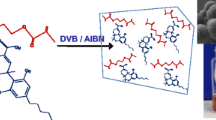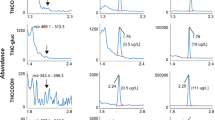Abstract
Synthetic cannabinoids (SCs) are the most rapidly growing class of recreational designer drugs. The rapid growth in popularity of SC use among teens and adults is of serious in our country as all of the world. These products are saturated in various plants crumb in order to make herbal appearence. They are not for human consumption and also their chemical structures are rapidly evolving. They are known as “Bonsai” in Turkey. 5F-ADBICA and 5F-NPB-22 are the two most commonly detected compounds in seized herbal products by police forces. The aim of this study was to determine and validate 5F-ADBICA and 5F-NPB-22 in whole blood and urine by LC/MS–MS. No method exists in the literature for the simultaneous determination of these new-generation SCs. 250 µL blank blood was transferred to 16 × 100-mm test tubes. Extraction was performed with 2 mL acetonitrile:ethyl acetate (25:75). The tubes were capped and rotated for 15 min. The samples were then centrifuged for 10 min at 3500 rpm. The organic layer was transferred to other tube and was evaporated to dryness at 45 °C under a stream of nitrogen. 0.5 mL of urine samples, 1.5 mL ice-cold acetonitrile and 0.5 mL of a 10 M ammonium formate solution were added. The mixture was shaken, centrifuged, and 1 mL of the organic layer was transferred into a separate vial and evaporated to dryness under a stream of nitrogen. The dried extracts were reconstituted with mobile phase A. The chromatographic separation was performed with a pentafluorophenylpropyl (PFPP) column (Allure 50 × 2.150 mm i.d., 5 μm, Restek, Bellefonte, PA, USA) using a gradient binary with 10 mM ammonium formate (A) in ultrapure water and methanol (B). The run time is 20 min. The method was validated in terms of limits of detection (LODs) (0.01–0.12 ng/mL) and quantification (LOQs) (0.03–0.36 ng/mL), extraction recovery (ER) (77.4–97.3%), matrix effect (ME) (63.3–83.6%), linearity, intra- and interday precision (CV ˂ 20%) and carryover. A simple, cost-effective, and accurate LC/MS–MS method has been developed for the simultaneous quantification of 5F-ADBICA and 5F-NPB-22 in whole blood and urine. The newly developed analytical methods allow the analysis of new-generation synthetic cannabinoids.







Similar content being viewed by others
References
Seely KA, Lapoint J, Moran JH, Fattore L (2012) Spice drugs are more than harmless herbal blends: a review of the pharmacology and toxicology of synthetic cannabinoids. Prog Neuropsychopharmacol Biol Psychiatry 39:234–243
Huffman JW, Dai D, Martin BR et al (1994) Design, synthesis and pharmacology of cannabimimetic indoles. Bioorg Med Chem Lett 4:563–566
Brents LK, Prather PL (2014) The K2/Spice phenomenon: emergence, identification, legislation and metabolic characterization of synthetic cannabinoids in herbal incense products. Drug Metab Rev 46(1):72–85
Weaver MF, Hopper JA, Gunderson EW (2015) Designer drugs 2015: assessment and management. Addic Sci Clin Pract 10:8
Van Amsterdam J, Brunt T, Van den Brink W (2015) The adverse health effects on synthetic cannabinoids with emphasis on psychosis-like effects. J Psychopharm 29(3):254–263
Hermanns-Clausen M, Kithinji J, Spehl M, Angerer V, Franz F, Eyer F, Auwärter V (2016) Adverse effects after the use of JWH-210—a case series from the EU Spice II plus Project. Drug Test Anal 8(10):1030–1038
Hudson S, Ramsey J (2011) The emergence and analysis of synthetic cannabinoids. Drug Test Anal 3(7–8):466–478
Aldlgan A (2016) Chromatographic analysis and survey studies to evaluate the emerging drugs of synthetic cannabinoids in Scotland and Saudi Arabia, Ph.D. Thesis, University of Glasgow, Scotland
Advisory Council on the Misuse of Drugs Cannabinoids (2014) Third generation synthetic cannabinoids, https://assets.publishing.service.gov.uk/government. Accessed 27 Nov 2014
Znaleziona J, Ginterová P, Petr J, Ondra P, Válka I, Ševcík J, Chrastina J, Maier V (2015) Determination and identification of synthetic cannabinoids and their metabolites in different matrices by modern analytical techniques—a review. Anal Chim Acta 874:11–25
UNODC early warning advisory on new psychoactive substances (2018). https://www.unodc.org/LSS/Home/NPS. Accessed 20 Dec 2019
Ong RS, Kappatos DC, Russell SGG, Poulsen HA, Banister SD, Gerona RR et al (2020) Simultaneous analysis of 29 synthetic cannabinoids and metabolites, amphetamines, and cannabinoids in human whole blood by liquid chromatography–tandem mass spectrometry—a New Zealand perspective of use in 2018. Drug Test Anal 12:195–214
Banister SD, Connor M (2018) In: Maurer HH, Brandt SD (eds) New psychoactive substances the chemistry and pharmacology of synthetic cannabinoid receptor agonists as new psychoactive substances: origins. Springer Nature Switzerland, Berlin
Akgül A, Aşıcıoğlu F (2011) New Trends in Narcotic Substances and Early Warning System. In: Demir OÖ, Sever M (eds) Organised Crime and New Trends. Polis Academy Press, Ankara [in Turkish]
Göla E, Cok I (2019) New psychoactive substances in Turkey: Narcotics cases assessed by the Council of Forensic Medicine between 2016 and 2017 in Ankara, Turkey. Forensic Sci Int 294:113–123
Aldlgan AA, Torrance HJ (2016) Bioanalytical methods for the determination of synthetic cannabinoids and metabolites in biological specimens. TrAC Trends Anal Chem 80:444–457
Behonick G, Shanks KG, Firchau DJ, Mathur G, Lynch CF, Nashelsky M et al (2014) Four postmortem case reports with quantitative detection of the synthetic cannabinoid, 5F-PB-22. J Anal Toxicol 38(8):559–562
Borg D, Tverdovsky A, Stripp R (2017) A fast and comprehensive analysis of 32 synthetic cannabinoids using agilent triple quadrupole LC–MS-MS. J Anal Toxicol 41(1):6–16
Dresen S, Kneisel S, Weinmann W, Zimmermann R, Auwarter V (2011) Development and validation of a liquid chromatography-tandem mass spectrometry method for the quantitation of synthetic cannabinoids of the aminoalkylindole type and methanandamide in serum and its application to forensic samples. J Mass Spectrom 46(2):163–171
Favretto D, Pascali JP, Tagliaro F (2013) New challenges and innovation in forensic toxicology: focus on the “New Psychoactive Substances”. J Chromatogr A 1287:84–95
Namera A, Kawamura M, Nakamoto A, Saito T, Nagao M (2015) Comprehensive review of the detection methods for synthetic cannabinoids and cathinones. Forensic Toxicol 33:175–194
ElSohly MA, Gul W, Wanas AS, Radwan MM (2014) Synthetic cannabinoids: analysis and metabolites. Life Sci 97:78–90
Vikingsson S, Gréen H, Brinkhagen L, Mukhtar S, Josefsson L (2016) Identification of AB-FUBINACA metabolites in authentic urine samples suitable as urinary markers of drug intake using liquid chromatography quadruple tandem time of flight mass spectrometry. Drug Test Anal 8(9):950–956
Knittel JL, Holler JM, Chmiel JD, Vorce SP, Magluilo J, Levine B, Ramos G, Bosy TZ (2016) Analysis of parent synthetic cannabinoids in blood and urinary metabolites by liquid chromatography tandem mass spectrometry. J Anal Toxicol 40:173–186
Zaitsu K, Nakayama H, Yamanaka M, Hisatsune K, Taki K, Asano T et al (2016) Erratum to: High-resolution mass spectrometric determination of the synthetic cannabinoids MAM-2201, AM-1220, AM-2232, and their metabolites in postmortem plasma and urine by LC/Q-TOFMS. Int J Legal Med 130:309–316
Freijo TD, Harris SE, Kala SV (2014) A rapid quantitative method for the analysis of synthetic cannabinoids by liquid chromatography-tandem mass spectrometry. J Anal Toxicol 38:466–478
Scientific Working Group for Forensic Toxicology (2013) Scientific Working Group for Forensic Toxicology (SWGTOX) standard practices for method validation in forensic toxicology. J Anal Toxicol 37:452–474
Matuszewski BK, Constanzer ML, Chavez-Eng CM (2013) Strategies for the assessment of matrix effect in quantitative bioanalytical methods based on HPLC-MS/MS. Anal Chem 75:3019–3030
Prabu S, Suriyaprakash T (2012) In: Naik GR (ed) Extraction Of Drug From The Biological matrix: A Review. RMIT University, Austraila
Salomone A, Gerace E, D’Urso F, Di Corcia D, Vincenti M (2012) Simultaneous analysis of several synthetic cannabinoids, THC, CBD and CBN, in hair by ultra-high performance liquid chromatography tandem mass spectrometry. Method validation and application to real samples. J Mass Spectrom 47:604–610
Kneisel S, Auwärter V (2012) Analysis of 30 synthetic cannabinoids in serum by liquid chromatography-electrospray ionization tandem mass spectrometry after liquid-liquid extraction. J Mass Spectrom 47:825–835
Tynon M, Homan J, Kacinko S, Ervin A, McMullin M, Logan BK (2017) Rapid and sensitive screening and confirmation of thirty-four aminocarbonyl/carboxamide (NACA) and arylindole synthetic cannabinoid drugs in human whole blood. Drug Test Anal 9(6):924–934
Dziadosz M, Weller JP, Klintschar M, Teske J (2013) Scheduled multiple reaction monitoring algorithm as a way to analyse new designer drugs combined with synthetic cannabinoids in human serum with liquidchromatography-tandem mass spectrometry. J Chromatogr Tandem Mass Spectrom 929:84–89
Chen MHH, Dip A, Ahmed M, Tan ML, Walterscheid JP, Sun H, Teng BB, Mozayani A (2016) Detection and characterization of the effect of AB-FUBINACA and its metabolites in a rat model. J Cell Biochem 117:1033–1043
Moran CL, Le VH, Chimalakonda KC, Smedley AL, Lackey FD, Owen SN et al (2011) Quantative measurement of JWH-018 and JWH-073 metabolites excreted in human urine. Anal Chem 83:4228–4236
Möller I, Wintermeyer A, Bender K, Jübner M, Thomas A, Krug O, Schänzer W, Thevis M (2011) Screening for the synthetic cannabinoid JWH-018 and its majör metabolites in human doping controls. Drug Test Anal 3:609–620
Scheidwiler KB, Huestis MA (2014) Simultaneous quantification of 20 synthetic cannabinoids and 21 metabolites, and semi-quantification of 12 alkyl hydroxy metabolites in human urine by liquid chromatography-tandem mass spectrometry. J Chromatogr A 1327:105–117
Dowling G, Regan L (2011) A method for CP-47,497 a synthetic non-traditional cannabinoid in human urine using liquid chromatography tandem mass spectrometry. J Chromatogr B 879:253–259
Emerson B, Durham B, Gidden J, Lay JO (2013) Gas chromatography-mass spectrometry of JWH-018 metabolites in urine samples with direct comparison to analytical standards. Forensic Sci Int 229:1–6
Polson C, Sarkar P, Incledon B, Raguvaran V, Grant R (2003) Optimization of protein precipitation based upon effectiveness of protein removal and ionization effect in liquid chromatography tandem mass spectrometry. J Chromatogr B 785:263–275
Ambroziak K, Adamowicz P (2018) Simple screening procedure for 72 synthetic cannabinoids in whole blood by liquid chromatography–tandem mass spectrometry. Forensic Toxicol 36:280–290
DuPont RL, Shea CL (2013) Drug Testing: A White Paper of the American Society of Addiction Medicine (ASAM). http://www.datia.org/datia/eNews/2014/DTWhitePaper.pdf. Accessed 18 Nov 2019
Synthetic cannabinoids (2016) Turkey Monitoring Center for Drugs and Drug Addiction. http://www.narkotik.pol.tr/Arsiv/TUBIM/Documents/. Accessed 10 Oct 2019
Funding
This research did not receive any specific grant from funding agencies in the public, commercial, or not-for profit sectors. It can have wide application in various analytical forensic and clinical laboratories.
Author information
Authors and Affiliations
Corresponding author
Additional information
Publisher's Note
Springer Nature remains neutral with regard to jurisdictional claims in published maps and institutional affiliations.
Rights and permissions
About this article
Cite this article
Efeoglu Ozseker, P., Daglıoglu, N. Simultaneous Determination and Validation of 5F-ADBICA and 5F-NPB-22 in Whole Blood and Urine by LC/MS–MS. Chromatographia 83, 1283–1291 (2020). https://doi.org/10.1007/s10337-020-03947-3
Received:
Revised:
Accepted:
Published:
Issue Date:
DOI: https://doi.org/10.1007/s10337-020-03947-3




